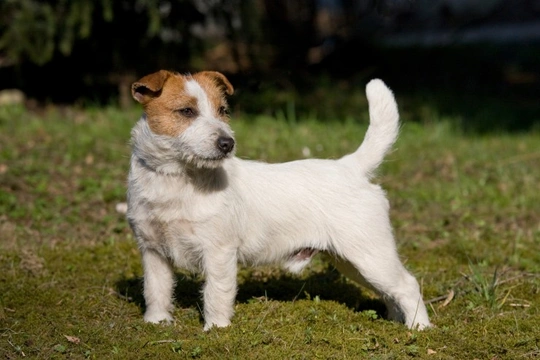
Spinocerebellar ataxia (SCA) testing for Jack Russell and Parson Russell terriers
Spinocerebellar ataxia or SCA for short is a hereditary health condition that leads to a progressive degeneration of the spinal cord, which affects the way that the spinal cord carries messages to the brain. The condition has been found in UK populations of the Jack Russell and Parson Russell terrier breeds, and the early symptoms can be confused with late onset ataxia, another hereditary condition that can be found within the same two breeds.
Spinocerebellar ataxia leads to progressive loss of coordination and balance that often presents with affected dogs displaying a distinctive prancing gait, and being apt to fall over. The condition can also lead to muscle spasms and rigidity of the spine, and attacks that look like seizures, but without the accompanying loss of consciousness and awareness that accompanies true seizures.
Additionally, the condition can place dogs at risk of true seizures (grand mal epilepsy) as well as overheating in warm weather or due to exercise.
The condition is progressive and cannot be cured, reversed or treated, and usually leads to euthanasia of affected dogs prior to the age of two, due to their poor quality of life.
Because spinocerebellar ataxia is a hereditary condition, it is not contagious and can only be passed from dog to dog by means of heredity, which means does that are a carrier of or affected by the condition may pass it on to their own offspring.
Because the symptoms of the condition become apparent while the dog is still young, it is unlikely that an affected dog will be used for breeding due to the obvious problems that they display-but carriers of the condition can still pass on the gene mutation that can cause spinocerebellar ataxia to their offspring, without ever suffering from it or showing symptoms themselves.
In order to reduce the spread of the condition in affected breeds, The Kennel Club oversees a screening scheme for spinocerebellar ataxia in the Jack Russell and Parson Russell breeds, and in this article we will look at the condition in more detail, including how the heredity of the condition works and how to get your dog tested. Read on to learn more.
More about spinocerebellar ataxia
Spinocerebellar ataxia is a progressive condition that causes damage to the myelin sheaths that protect the nerve pathways in the spine, causing them to break down and be unable to pass messages to the dog’s brain.
The onset of the condition tends to begin when the dog is still very young, usually between the ages of two and nine months of age, and ultimately, few dogs with the condition live past the age of two.
What sort of dogs can be affected by the condition?
In the UK, spinocerebellar ataxia has been identified as a risk to the Parson Russell and Jack Russell breeds, but has also been found in some international populations of smooth haired fox terriers and toy terriers too.
Cross breed dogs with one parent dog from one of the affected breeds can pass on the gene fault for the condition on gto their offspring, but because it is the combination of genes inherited from both sides of the breed line that dictates the dog’s status, out-crossing to an unrelated breed significantly reduces the dog’s chance of inheriting the affected form of the condition.
However, it is important to note that the crossing of Jack Russells with Parson Russells is fairly common, and in this case, the chances of inheriting the condition are equivalent to those of purebred dogs of the same respective breed, because both breeds can inherit the condition.
How does the heredity of the condition work?
Spinocerebellar ataxia is an autosomal recessive hereditary condition, which means that inheritance of the faulty gene that causes the condition from one parent alone is not enough to cause the affected form of the condition in the dog’s offspring.
Dogs are assigned a status for the condition, being either clear, carrier or affected respectively, and knowing the status of the two parent dogs allows you to identify the status their puppies will be too.
- Two clear dogs will have clear puppies.
- Two affected dogs will have affected puppies.
- Two carriers will have 50% carriers, 25% affected and 25% clear.
- A clear dog and a carrier will have 50% clear and 50% carrier offspring.
- A clear dog and an affected dog will have a litter of carriers.
- A carrier and an affected dog will have 50% carriers and 50% affected.
How to get your dog tested
In order to find out your dog’s status and so, make an informed decision about breeding from them and be able to reassure the buyers of the puppies about the status of their pup, you simply need to ask your vet to take a DNA sample from your dog, and send it off to one of The Kennel Club’s approved laboratories for testing.



